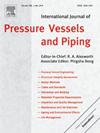天然气喷射火焰下架空钢质管道热机械故障的定量研究
IF 3
2区 工程技术
Q2 ENGINEERING, MECHANICAL
International Journal of Pressure Vessels and Piping
Pub Date : 2024-10-29
DOI:10.1016/j.ijpvp.2024.105350
引用次数: 0
摘要
平行架空管道尤其善于穿越错综复杂的地形。然而,最初的管道事故导致喷射火焰的出现,会引发相邻管道的故障,从而加剧整体状况。因此,研究管道在天然气喷射火焰中的热机械反应至关重要。在燃烧机理的基础上,针对天然气喷射起火情况下的全尺寸钢制管道开发了一个瞬态热机械耦合模型。随后分析了这些管道的热机械响应特性,并定量评估了四个不同变量对管壁温度和归一化应力的影响。最后,提出了一种针对喷射火焰管道的安全评估方法,该方法将临界热失效标准与 PSO-LSTM 算法相结合。结果表明,所提出的热机械耦合模型能有效模拟喷射火焰对管道的热效应,模型误差小于 10%。值得注意的是,原油流速对管道热失效的影响最为明显。已建立的热机械故障标准与 PSO-LSTM 混合模型(平均误差为 5.57%)相结合,能够快速预测各种运行情况下的关键故障条件。本文章由计算机程序翻译,如有差异,请以英文原文为准。
Quantitative study on thermal-mechanical failure of overhead steel pipelines under natural gas jet fire
Parallel overhead pipelines are particularly adept at traversing intricate terrains. Nonetheless, the emergence of jet flames due to initial pipeline incidents can precipitate failures in adjacent pipelines, thereby intensifying the overall situation. Therefore, it is essential to examine the thermal-mechanical responses of pipelines exposed to natural gas jet fires. Building on combustion mechanisms, a transient thermal-mechanical coupling model has been developed for full-scale steel pipelines in the context of natural gas jet fires. The thermal-mechanical response characteristics of these pipelines are subsequently analyzed, and the impacts of four distinct variables on pipe wall temperature and normalized stress are quantitatively evaluated. Ultimately, a safety evaluation methodology for pipelines subjected to jet flames is proposed, which integrates critical thermal failure criteria with PSO-LSTM algorithm. The results demonstrate that the proposed thermal-mechanical coupling model effectively simulates the thermal effects of jet fires on pipelines, achieving a model error of less than 10 %. Notably, the flow velocity of crude oil has the most pronounced effect on the thermal failure of the pipeline. The established thermal-mechanical failure criterion, in conjunction with the PSO-LSTM hybrid model (average error of 5.57 %), enables the rapid prediction of critical failure conditions across a wide range of operational scenarios.
求助全文
通过发布文献求助,成功后即可免费获取论文全文。
去求助
来源期刊
CiteScore
5.30
自引率
13.30%
发文量
208
审稿时长
17 months
期刊介绍:
Pressure vessel engineering technology is of importance in many branches of industry. This journal publishes the latest research results and related information on all its associated aspects, with particular emphasis on the structural integrity assessment, maintenance and life extension of pressurised process engineering plants.
The anticipated coverage of the International Journal of Pressure Vessels and Piping ranges from simple mass-produced pressure vessels to large custom-built vessels and tanks. Pressure vessels technology is a developing field, and contributions on the following topics will therefore be welcome:
• Pressure vessel engineering
• Structural integrity assessment
• Design methods
• Codes and standards
• Fabrication and welding
• Materials properties requirements
• Inspection and quality management
• Maintenance and life extension
• Ageing and environmental effects
• Life management
Of particular importance are papers covering aspects of significant practical application which could lead to major improvements in economy, reliability and useful life. While most accepted papers represent the results of original applied research, critical reviews of topical interest by world-leading experts will also appear from time to time.
International Journal of Pressure Vessels and Piping is indispensable reading for engineering professionals involved in the energy, petrochemicals, process plant, transport, aerospace and related industries; for manufacturers of pressure vessels and ancillary equipment; and for academics pursuing research in these areas.

 求助内容:
求助内容: 应助结果提醒方式:
应助结果提醒方式:


